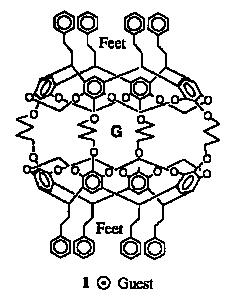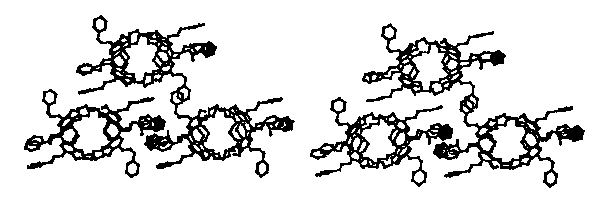
AN ADAPTABLE HOST FOR ORGANIC GUESTS AND THEIR REACTIONS. E. F. Maverick, C. B. Knobler and D. J. Cram, Dept. of Chemistry and Biochemistry, UCLA, Los Angeles. CA 90095.*
'Hemicarcerand' host 1 forms stable complexes with guests ranging in size from xenon to phenyl allyl ether. The inner phase provided by the container is a favorable location for selected chemical reactions.1
Crystals of l s Guest 2PhNO2 grow from solutions containing nitrobenzene.
The phenethyl 'feet' of the host are organized so that six feet from neighboring complexes encapsulate two nitrobenzene molecules, while the remaining two feet 'shake hands'. (PhNO2 is darkened in the stereoview below; guests are omitted.) Twenty-four structures with different guests, 23 of them isostructural, have the same general features for the hemicarcerand moiety. Many are low resolution structures
with poorly determined guests. Even so, the orientation of the guest can be deduced and the inter-hemispheric distance is reasonably well determined, allowing conclusions to be drawn about the guest's influence on the host.
1 Robbins, T. A., Knobler, C. B., Bellew, D. R. and Cram, D. J. J. Am. Chem. Soc. 1994,116, 111-122; Kurdistani, S. K., Helgeson, R. C. and Cram, D. J. J. Am. Chem. Soc. 1995, 117, 1659-1660.
* Research supported by U.S. Public Health Services Grant GM-12640.

